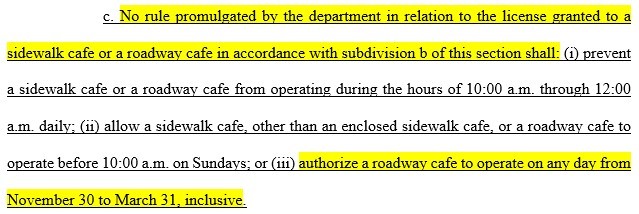On August 3, the New York City Council approved Intro 31-C, the third iteration of its legislation to make permanent the 2020 Mayoral Emergency Order permitting City bars and restaurants to expand onto the adjoining sidewalks and streets. Intro 31-C was only marginally amended from Intro 31-B (see R&E’s May 24 email alert: Deep Dive into Intro 31-B: NYC’s Proposal for Permanent Outdoor Dining).
The only difference between 31-B and 31-C is that 31-C clarifies that sidewalk cafés include cafés located within sidewalk widenings. (Note: sidewalk widenings are required in certain zoning districts such as, e.g., C4-4L, C6-3A, and in certain special purpose districts, including Midtown, Lower Manhattan, Hudson Yards, Downtown Brooklyn, Long Island City, and Gowanus, among others. Although sidewalk widenings are on private property, because their purpose is to provide increased pedestrian circulation space, they are treated as extensions of the public sidewalk.)
One of the many provisions of 31-C that did not change was the provision that many believed would require roadway sheds to be dismantled and removed every year from December until April. The New York Times reported that roadway sheds “will have to be removed for the winter, and reconstructed in the spring — a requirement that some restaurateurs say will be a costly and onerous burden,” and quoted one restaurant owner saying, “If I have to take it down, where am I going to store it?” The law requires no such thing. Here is the provision:

As you can see, the text says only that the Department of Transportation may not promulgate any rules that would allow a roadway shed to “operate” from November 30 to March 31. Neither here nor in any other provision of the law does it say that roadway sheds must be removed during those months, only that they may not operate. The Technical Memorandum, issued the same day as 31-C was approved, says the very same thing:

If it was really the intention of the Council to require the sheds’ removal, they could have – and should have – said so in no uncertain terms. But they didn’t. So, it will almost certainly be only a matter of time before a restaurant legally challenges an order by DOT to remove their roadway shed after November 30, by arguing that the plain language of the law doesn’t require removal, only that the shed not be operated. “I padlocked it and I’m not using it, so I’m in full compliance with the law,” they will argue. And a court will have no option but to agree because the text doesn’t indicate that the shed must be removed. It remains a mystery (a) how anyone could read this provision as requiring dismantling and removal, and (b) if that was indeed the Council’s intent, why they decided to leave this provision as is.
Another thing about 31-C that remained unchanged from 31-B is that it has no provisions whatsoever related to enforcement. As pointed out in R&E’s previous alert, the first iteration of the law, Intro 31-A, contained provisions mandating the establishment within DOT of an “Office of Street Commerce Enforcement,” with “a sufficient number” of street patrols to allow inspection of not less than 75% of the outdoor dining sheds every year. However, 31-C, like 31-B, contains no such provisions and, like 31-B, is entirely silent as to how or by whom the law will be enforced. This is no small oversight. The cost to City taxpayers for licensing, inspection and enforcement will likely be $10-$15 million per year.
It is sometimes said that bad policy makes for bad law. A policy allowing outdoor dining on the City’s sidewalks and streets isn’t necessarily a bad policy, but a law implementing a policy that is vague as to its requirements and completely silent as to its regulation and enforcement – and cost – is a bad law.
If you have any questions about Intro 31-C or how permanent outdoor dining will impact your property, please contact your trusted R&E attorney or Frank E. Chaney, Head of the firm’s Zoning and Land Use Department, who authored the above.
